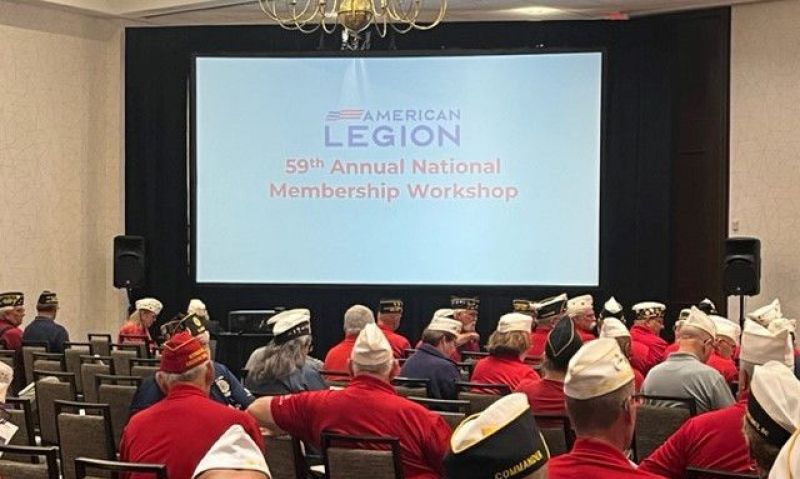
National Membership Workshop attendees hear best practices for a successful post and district revitalization, along with membership recruiting ideas.
American Legion post and district revitalization efforts provide an opportunity for members currently residing in a department headquarters post to transfer into a post in or near their community. It’s also an opportunity to sign up new members and check on fellow veterans.
Revitalization efforts can be held at a post or community space where post, district and department leadership are in attendance. During the National Membership Workshop in Indianapolis July 29, attendees heard best practices for conducting a post and district revitalization from Department of Idaho Adjutant Abe Abrahamson.
– Have an American Legion service officer available to help answer veteran benefits questions or file a claim.
– Provide a free lunch. Feature this free lunch on the back of the postcards that national staff mails out prior to the revitalization that invite veterans to renew, join and learn more about The American Legion. “How many people in your community don’t know what you do?” Abrahamson asked workshop attendees. “How many veterans don’t know what you do? How many veterans don’t know who we are? Why is this? Because we don’t do a good job telling everybody how great we are. Your post needs to add free lunch (to the back of the postcards) and ‘Please bring your family and come down and see us.’ Invite them down to meet you. Give them a reason to come. Make it family inviting.”
– Create packets of take-home materials for potential new members who attend the revitalization. The packets can include a post or department newsletter, membership application and brochures on American Legion programs.
– Go online to 411.com if there isn’t a phone number on the membership roster provided during the revitalization. A phone number will often come up after typing in a name and home address.
– Identify one phone number to leave behind for members to call back if a voicemail must be left.
– Make a list of headquarters post members who couldn’t be reached to call before each post meeting.
– Gather as much information as possible when filling out the Member Data Form to transfer a headquarters member into a post home – email address, branch of service, home address, etc.
– Engage the transferred members – send a post newsletter, have the post commander make a welcome phone call, and invite the member to the post for a meeting or dinner. “Your job from the day they transferred is to build value in your post,” Abrahamson said. “Because if you haven’t built value in those months (before the renewal notice comes) they are not going to renew.”
– Conduct an initiation ceremony with the transferred members. “Just because they are DMS members, you can still bring them down to the post and do an initiation ceremony. I believe that’s important,” Abrahamson said because as they stand before post leadership and members with their right hand raised, “what are they doing? They are making a commitment to your organization. They are making a commitment to your post.”
– Recognize all volunteers who helped with the revitalization effort. Abrahamson recommends presenting the certificates of recognition during a department convention or mid-winter conference. “Recognize your people in front of people. It does you no good to mail a certificate to somebody’s house.”
Abrahamson echoed the remarks of Past National Commander Marty Conatser to Membership Workshop attendees that membership is like a sales job. “To do your sales job, you have to know what you’re selling,” Abrahamson said. “You don’t show up at a car dealership and say, ‘Hey, tell me about this car’ and the salesman goes ‘Yep, it has four wheels.’ He’s going to tell you every single thing about that car so that you fall in love with it and buy it. The Legion is no different. You can explain to them everything about it that’s great, but if you don’t know the information, how can you sell it? Build the value.”
That value in The American Legion is the reason for joining, Membership and Post Activities Committee Chairman Jay Bowen said. “The reason you joined, the reason you stay a member of The American Legion, is probably different than why I’m doing it. But that’s OK. I see the value in The American Legion. You obviously see the value in The American Legion. We have got to make our veterans, our Legionnaires, our members believe and understand that there is a value in their membership. And we have to continue to push that.”
MEMBERSHIP TIPS
– Department of Arizona Membership Director Steven Sperl has a QR code on the back of his American Legion business card that takes potential members to the department’s online membership application where veterans can sign up and pay dues. Sperl also puts the QR code on every membership article he writes that’s featured on the Department of Arizona’s website, Facebook page and Twitter account. “We need to embrace it and we need to use it,” he shared with Membership Workshop attendees during his presentation on membership recruitment.
- The business card of Department of Utah Commander Doug Case has his Post 11’s address, monthly meeting day and time, American Legion national website and website information to access military records/DD-214. “I give these out to every veteran I see,” Case said during the membership recruitment session.
– Each time a district commander in Illinois visited a post in his district, he arrived an hour early to knock on the doors of two expired members from the respective post. Conatser said that 19 of the posts in the district achieved 100% membership. “It’s easy on the phone, it’s easy in a letter, it’s not so easy when you’re standing on the front porch to say no (to joining or renewing),” Conatser said.
- Membership

